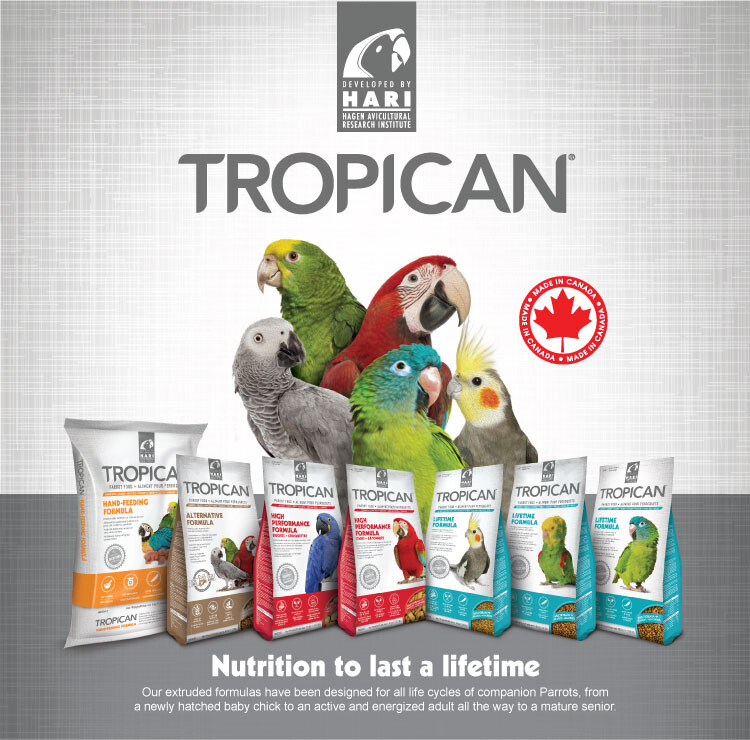Blog
HARI Bird Food Feeding Guide and Instructions
Bringing a bird into your home as a pet can be a delightful and rewarding experience. Birds, with their vibrant colours and cheerful songs, can brighten up any household. However, like any pet, they require proper care and nutrition to thrive. One essential aspect of keeping your feathered friend healthy is providing them with the right diet. Hari Bird Foods offers a range of quality bird food products designed to cater to different species’ dietary needs. In this blog, we will explore the dosage and instructions for using Hari Bird Foods to ensure your avian companion’s well-being.
Understanding Hari Bird Foods
Hari Bird Foods is a reputable brand known for producing high-quality bird food blends that are specifically formulated to meet the nutritional requirements of various bird species. They use a combination of seeds, grains, fruits, vegetables, and essential vitamins to create balanced diets suitable for parrots, cockatiels, lovebirds, and other pet birds. Let’s explore the variety of Hari Bird Foods.
1. The Hand-Feeding Formula:Alongtime favourite of aviculturists and parrot breeders alike, is the result of HARI’s industry-leading research and development. Breeders of parrots all over the world are increasingly counting on Tropican Hand-Feeding Formula to give their young birds all the nutrients they need for healthy development and spectacular plumage. A finely ground version of the high-performance biscuits is the Hand-Feeding Formula. Included here are the advantages of high-temperature extrusion cooking, such as the gelatinization of the starches that enhances the formula’s ability to retain water, the eradication of field bacteria, and simpler digestion.
The innovative Hand-Feeding Formula from Tropican provides all the nutritional power that makes it a top choice for baby parrot food. It is a superior supply of protein and fat generated from peanuts, as well as a source of vital grains that complete amino acid profiles, all of which are required for the healthy development and wellbeing of parrot chicks from hatch to fledging age. Tropican makes feathers shine and supports a healthy body because it is a high source of omega fatty acids from flaxseed, peanuts, and sunflower seeds.
Formula Preparation
Tropican Hand-Feeding Formula should be mixed with hot water in the proper proportion; otherwise, use cold water and a microwave. Food should always be thoroughly mixed, and hot areas should be avoided. It will take a minute to completely moisturise with water due to Tropican’s advantageous gelatinization abilities. So it is suggested to adjust the consistency. If extra water is required, simply add a little more.
Final temperature should never exceed 40.5°C (105°F) and should always be slightly above body temperature (38°C-100°F). The ideal temperature should always be confirmed with an exact, calibrated thermometer. Food that has been overheated can cause crop, throat, and mouth tissue burns. Keeping chicks at the right temperature should be based on the recommended brooder temperature.
A thorough diet is provided with Topican Hand-Feeding Formula for Baby Parrots. This food should not be mixed with other baby foods since the mixture can lose its nutritional balance and become deficient in important nutrients.
Feeding Guide
Administration of food with a feeding syringe is recommended, provided you are confident of the proper technique to be used. Use a separate syringe for each clutch. If you are not confident with syringe feeding, a spoon bent on either side can also be used.
-
Place the syringe tip slightly into the left side of the beak with one hand. Pressure should be placed on the Beak’s commissures with the fingers of the other hand and palm of the hand held behind the head of the chick, preventing the syringe from injuring the mouth when the chick will react with a feeding response.
-
When the bird gives a feeding response (head pumping), start feeding and aim towards the back right side of the mouth. Close monitoring of chick response and respiration is essential to preventing aspiration. Fill the crop without excess stretching.
-
A daily weight monitoring and amount fed chart should be kept for health growth parameters and future reference. Allow the crop to completely empty between feedings.
-
A bent teaspoon may also be used to slowly drip food into the beak. Metal feeding tubes are not recommended, as they can pierce the crop and oesophagus, allowing food to leak out.
Recommended Species
-
AFRICAN GREYS • AMAZONS • COCKATIELS • COCKATOOS • CONURES • ECLECTUS • LOVEBIRDS • MACAWS • PIONUS • MOST PSItTACINES
Who can benefit from Hand-Feeding Formula?
Up until the fledgling stage, newborn parrots can be fed hand-feeding formula. As an additional food source, it can also be offered dry to small species like Lories, Finches, Canaries, and other birds.
2. The High PerformanceFormula:A high-performance diet satisfies the higher nutritional needs of growing parrots (hand-feeding from hatch) and growing parrots (parental egg-laying and child rearing). It is a top-notch supply of fat and protein obtained from peanuts, as well as vital grains that balance amino acid profiles, all of which are important for the growth of feathers and muscles. Flaxseed, peanuts, and sunflower seeds are excellent sources of Omega fatty acids, which make feathers shine and maintain a healthy physique.
Digestibility and Nutrient Density
Our much higher fat content is one of the key distinctions between Tropican High Performance Parrot Food and other products. Our birds developed moist, foul droppings when we gave them other foods. These products, which resemble chicken feed because they look like it, are essentially glorified agricultural pellets that are probably the least expensive to create. Essential fatty acids and amino acids are present in these items in very small amounts. HARI made the decision to add additional fat to our formula’s caloric density to reduce the amount of food and liquid the bird has to consume. We promise that the high-performance diet will contain a minimum of 11% fat. This amounts to roughly twice as much fat as other pellets. In addition to having no issues with obesity, HARI has never had any skinny birds. If they don’t add oil seeds like sunflower to these pellets, other breeders that employ diets with lower fat levels report skinny African Greys and Cockatoos. Any pellet that requires additional oil, seeds, or fruits cannot really be considered complete.
Feeding Guide
To Keep your pet bird healthy, water cups should be cleaned daily, and food should be replenished as needed. Tropican extruded granules, sticks and/or biscuits should be replenished as needed.
Recommended Species
-
COCKATIELS • LOVEBIRDS • SMALL CONURES • QUAKERS • CONURES • CAIQUES • PIONUS • AMAZONS • MACAWS • COCKATOOS • AFRICAN GREYS • SENEGALS
Who can benefit from high-performance Formula?
High Performance Formula is suitable for young, weaning and fledgling Parrots. It can also be fed to breeding Parrots or for Parrots that require a heartier diet. View the photo gallery below to learn more about the benefits of providing Tropican High Performance Formula to your pet bird.
3. LifetimeFormula: For companion birds that are not moulting or experiencing any other stress, such as reduced weather, Lifetime Formula, a parrot meal with less protein and calcium, was created. Natural colours like those in carrots and lucerne give the bird appeals without being artificial. The preservation of a healthy lifestyle for fledged juvenile to adult Parrots depends on an excellent amount of fat and protein obtained from peanuts as well as a source of vital grains that complete amino acid profiles. Flaxseed, peanuts, and sunflower seeds are excellent sources of Omega fatty acids that make feathers shine and maintain a healthy physique.
Feeding Guide
To Keep your pet bird healthy, water cups should be cleaned daily, and food should be replenished as needed. Tropican extruded granules, sticks and/or biscuits should be replenished as needed.
Recommended Species
- COCKATIELS • LOVEBIRDS • ROSELLAS • PARROTLETS • CONURES • CAIQUES • QUAKERS • PIONUS • AMAZONS• MACAWS • COCKATOOS • GREYS • SENEGALS • SELECT LORIKEET & LORY SPECIES
Who can benefit from Lifetime Formula?
Lifetime Formula is appropriate for newly fledged juvenile parrots and adults. Additionally, it can be given to smaller psittacine species at all phases of development and during the reproductive season.
4. Alternative Formula: Alternative Formula, a diet with 15% protein, was developed for companion birds who are diet challenged, adults, and/or seniors. It’s a great soy-free diet that is rich in peas and quinoa as substitutes for high-quality protein sources. Due to their high digestibility rating and excellent complimentary amino acid profile when paired with the other plant-derived proteins (wheat, rice) present in the Alternative Formula, peas are a premium source of protein. To make the food more palatable for parrots, natural components such as peanuts, sweet potatoes, and pumpkin seeds are included. The lustre of feathers is enhanced by a strong dose of Omega fatty acids found in flaxseed and peanuts, which also support a healthy body.
Feeding Guide
To Keep your pet bird healthy, water cups should be cleaned daily, and food should be replenished as needed. Tropican extruded granules, sticks and/or biscuits should be replenished as needed.
Recommended Species
-
AFRICAN GREYS • AMAZONS • COCKATOOS • CONURES • ECLECTUS • QUAKERS • MACAWS • PIONUS
Who can benefit from Alternative Formula?
For parrots with less active lifestyles and/or dietary issues, Alternative Formula is appropriate. Additionally, it can be offered to mature and elderly parrots who need less protein and fat as well as to non-breeding, non-molting birds.
5. Egg GranulesFormula:
Tropican Egg Granules are an extruded mixture of grains, eggs, and necessary vitamins and minerals that are designed specifically for budgies, canaries, finches, and other tiny birds. A specially developed egg meal pellet provides the necessary protein, fats, and carbohydrates for perfect and vibrant feather growth as well as strong muscles and bones, as well as the additional advantages of critical vitamins and amino acids that support their growth. Birds require extra protein during moulting and breeding. They receive a nutrient-rich boost by including egg food in their everyday diet during this difficult time. You can be sure you are providing your bird with a comprehensive and balanced diet when you feed it enrichment foods like veggies and seeds.
Feeding Guide
For budgies, canaries, finches and other small birds offer
- 70% Tropican Egg Granule
- 30% Enrichment foods such as seeds, vegetables (and small amount of fruits).
- Don’t forget! PRIMEone to two times a week sprinkled on kale or other moistened enrichment foods!
As with any new food, introduce it gradually by switching in 20% every week with the current food. Can be moistened slightly to increase consumption. Remove any uneaten, moist food from your bird’s cage daily and discard it. Fresh, clean water should be replenished daily. Always consult with your Avian veterinarian to ensure your bird has complete and proper nutrition.
During the moulting and breeding seasons
- Give daily. Two or three times a week for the rest of the year.
Feed as a supplement to all other cage birds.
-
Sprinkle a small amount (1–2 tbsp) over your bird’s daily diet.
For Grass Keet Species feed
-
50% Tropican Egg Granule
-
25% Tropimix Egg Food
-
25% seeds, such as Hagen VME Budgie
-
PRIME1- 2x a week sprinkled on kale or other moistened enrichment foods.
Recommended Species
- BUDGIES • CANARIES • FINCHES • PARROTLETS • LINEOLATED PARAKEETS • AUSTRALIAN GRASS PARAKEETS • OTHER SMALL BIRDS • AS A SUPPLEMENT FOR ALL BIRDS
Conclusion:
Feeding your bird a well-balanced diet is crucial to their overall well-being and longevity. Hari offers a variety of carefully formulated blends to cater to the specific dietary needs of different bird species. By following the dosage and instructions provided and ensuring your bird’s diet is supplemented with fresh fruits and vegetables, you can give your avian companion the best chance at a healthy and happy life. Always remember to consult with an avian veterinarian if you have any concerns about your bird’s health or dietary needs. Happy bird-keeping!





